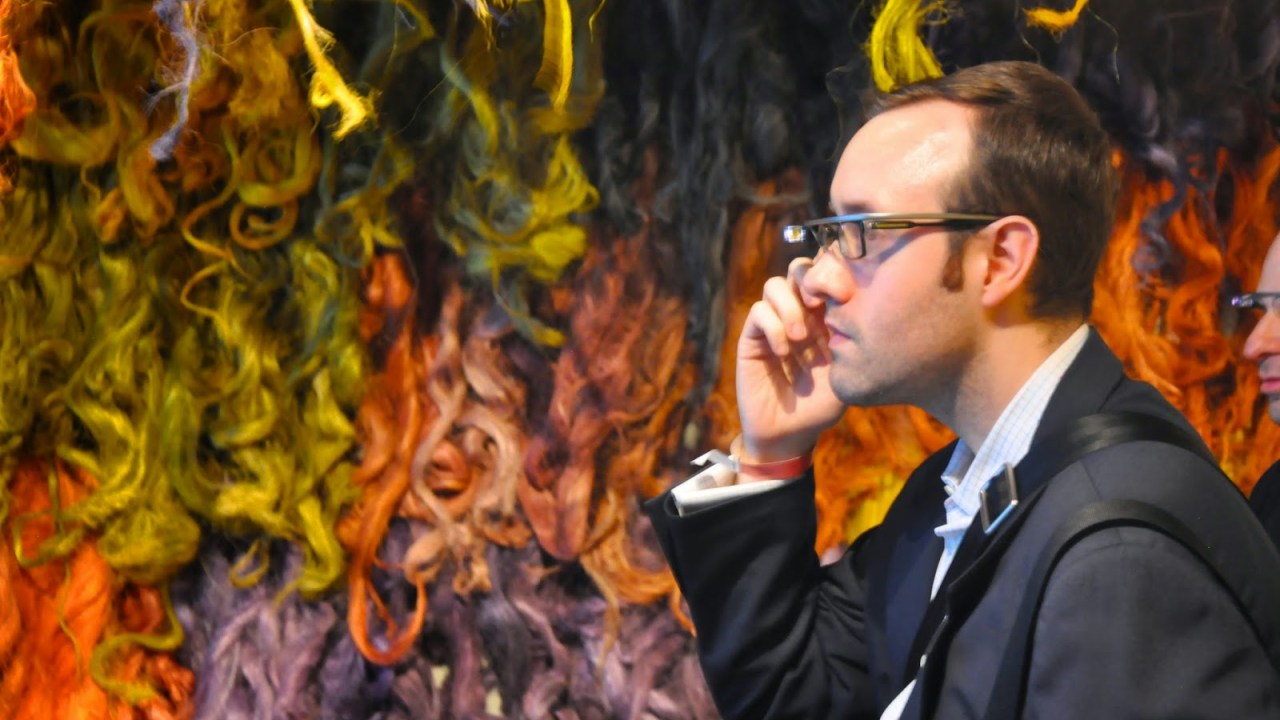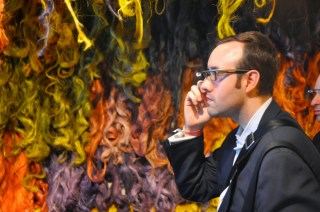
Exploring the Wearable Future, Part II
I hope you enjoyed Tuesday’s preview of the mock Museum of the Future CFM is staging in MuseumExpo at the annual meeting week after next. Neal Stimler, an early adopter of Google Glass, will be helping me with the demonstration. In today’s post he contributes some thoughts and resources to prime your thinking. During the meeting, look for hashtag #cfmwearables15 on Twitter to follow the conversation generated by the Museum of the Future, and contribute your thoughts.
(Neal asked me to include the disclaimer that his remarks are his personal views, and do not necessarily reflect the views of The Metropolitan Museum of Art. Also, please note any mention of a specific company, product or service is not a paid endorsement, but is provided for your enjoyment, learning and reference.)
(Neal asked me to include the disclaimer that his remarks are his personal views, and do not necessarily reflect the views of The Metropolitan Museum of Art. Also, please note any mention of a specific company, product or service is not a paid endorsement, but is provided for your enjoyment, learning and reference.)
 |
| Neal Stimler & Google Glass at the Bard Graduate Center Photo: Raffi Asdourian |
Greetings friends and followers of the Center for the Future of Museums! I’m Neal Stimler, Digital Asset Specialist at The Metropolitan Museum of Art in New York City. At the Metropolitan Museum of Art, I forecast trends, lead digitization efforts and manage special initiatives. I also explore wearable technologies like Google Glass and the Moto360 smartwatch. I’m especially interested to study how museum collections and content are experienced with wearable technologies as well as how wearables can improve customer service for museum constituents.
I’m delighted to be joining Elizabeth Merritt, GuidiGo and other collaborators for the Center for the Future of Museums’ MuseumExpo experience at the 2015 Annual Meeting. As Elizabeth mentioned in her recent post on April 14, 2015, I was one of the first people in the cultural heritage and museum sectors to experiment with Google Glass as a Google Glass Explorer and an #ifIhadglass winner. I have traveled in the United States and Europe, notably in Denmark and Italy, sharing Google Glass and the Moto360 with museum and technology professionals. I enjoy facilitating people’s introductions and learning experiences with wearable technologies as they consider the applications of these tools in daily life and their professions.
I join Elizabeth in inviting you to visit the special Google Glass demo in The Museum of The Future in MuseumExpo. Try Google Glass and the other wearable devices we will have on hand for yourself and share your experiences on Twitter. I’ll be at the MuseumExpo to answer your questions about wearables and help you become more comfortable navigating these devices. Please feel free to dialogue with me before, during and after the 2015 American Alliance of Museums Annual Meeting on Twitter @nealstimler.
Five Themes on Wearables
Here are five themes on wearables for your consideration prior to MuseumExpo experience at the 2015 Annual Meeting.
1. BYOD Mobile Morphs to Wearable:
The New Media Consortium Horizon Report: 2013 Museum Edition identified and the 2015 report wikifurther addresses BYOD, or “Bring Your Own Device,” as a continued and hastening trend for museums.
Wearables devices are now part of the BYOD paradigm that require further consideration from museums. Wearables as BYOD devices in museums necessitate that museums: 1. Re-examine media making and recording policies to address contemporary practices including body worn, heads-up and wrist devices for museum constituents and staff. 2. Provide technical infrastructure, such as open WiFi and free charging stations, for museum constituents onsite so that they may continue to interact with personal and museum content. 3. Shift design paradigms and workflows to serve museum content for a mobile and wearable platforms first to maximize opportunity for engagement and reach onsite and offsite.
I encourage you read the full New Media Consortium Report: 2015 Editionwhich will cover more recent perspectives and timelines for BYOD when it’s available. There will also be a session at the 2015 American Alliance of Museums Annual Meeting on the report.
2. Seek To Understand Rather Than Ban:
It will be important for museums to take an active rather than reactive approach to wearable technologies. As institutions dedicated to aesthetic appreciation, creativity, discernment, and learning, experimentation with wearable technologies is aligned with museums’ missions. With collections that document human ingenuity, programs that teach critical thinking and technical skills and staff whose research offers new scholarly insights, museums are optimal platforms to explore wearable technologies. It is through careful and mindful study of wearable technologies in dialogue museums that we may come to better understand them.
Pivotal to museums being able to understand wearable technologies is supporting efforts like the MuseumExpo, where museum professionals can come together to demonstrate and try these technologies. Museums that have access to wearable technologies play a vital role in leading these efforts by collaboratively sharing their expertise and resources with the broader community of professionals.
3. Connected and Customized Customer Service:
Applications on mobile devices connect individuals to the content they care about and enable them to facilitate interactions with products and services they value. Like mobile devices, wearable technologies will further integrate into the fabric of customers’ daily lives. Museums have an opportunity to better serve constituents’ needs through responsiveness via wearable technologies.
While this may come through museums own applications, it is likely that museums can address business on wearable devices in partnership with extant and popular third party applications who have the development capacity and resources to more quickly adapt to meet customer needs. By being where users already are, museums can more readily adapt to constituents’ preferences and provide customer service that meets contemporary expectations. Museum constituents must be able to continue their social and transactional activities before, during and after they cross the onsite threshold and in offsite interactions.
Wearable technologies ought to be considered not only as the next generation of multimedia guides, but moreover as essential tools for maintaining customer relations, building new agile patronage models and fulfilling essential services including navigation, reservations and ticketing. The relationship between a museum and constituent with wearable devices is an intimate and embodied one, which requires both attentiveness to a superb customer experience and a sensitivity to aesthetic and design concerns. Customers as well will want to customize their museum experience with wearables to suit their preferred applications, devices and platforms.
4. Open Access Fosters Creative Potential:
Museums can foster creative potential by opening access to data and assets and thereby build an ecosystem of content for wearable devices. This includes revising rights policies towards open access when possible, building technical infrastructure and delivery mechanisms so that commercial developers and artists have the resources needed to make applications for wearable devices. Barriers to access mean that developers and artists will go elsewhere for content sources when producing commercial and creative projects. Museum data and assets can be dynamic resources for the making of new products, services and interconnected cultural experiences. Opening access to data and assets is key, but so too is nurturing an engaged community of practice around these resources through the work of museum media labs and maker spaces.
With mobile and wearable devices, museums benefit by having their data and content linked and spread across platforms far beyond their own institutional bases. The museum, its collections and content, is not bound by walls but is an active part of constituents’ everyday experiences at a glance anywhere and anytime with wearables. Artists, many of whom adopted mobile as an interactive canvas for cultural production, will turn to wearable devices as well to communicate their expressions of the world.
5. Art of Wearables, Wearables As Art:
The Cooper Hewitt has an iPhone in its collection and currently on display in its revitalized galleries. It is important for museums to learn about the emulation, interaction and preservation of mobile as it morphs to wearable technologies now, so that museums can be good stewards to collections in the present and future. Wearable technologies will join the grounds of the past that served as supports for artistic communication and expression. The histories of mobile and wearable technologies are part of the histories of art, design, fashion and graphics.
Mobile and wearable devices are tools we use to design daily networked life. Wearable devices, like museums, are tools for consuming and producing contemporary culture. Museums and wearable technologies are at the nexus of a reality that is unified aesthetically and humanistically with the digital and physical. This is Digital Monism.
Five Wearable Technology News Sources
Sources are listed alphabetically.
CrunchWear
Website: http://www.crunchwear.com/
Facebook: https://www.facebook.com/crunchwear
Twitter: https://twitter.com/crunchwear
Wareable
Website: http://www.wareable.com/
Facebook: https://www.facebook.com/Wareable
Twitter: https://twitter.com/wareable
We Are Wareables
Website: http://www.wearewearables.com/
Instagram: https://instagram.com/wearewearables/
Twitter: https://twitter.com/WeAreWearables
Wearable Technology Conference and Expo
Website: http://www.wearabletechworld.com/
Twitter: https://twitter.com/WearableTechCon
Wearable Technologies
Twitter: https://twitter.com/WearableTech
Five Mobile Applications for Museum Professionals
The applications listed below are available on Android and/or iOS. Some already provide integration with AndroidWearapps and notifications. Others have wearable features coming soon. The applications are listed alphabetically.
Attopedia
Daily Art
Website: http://www.getdailyart.com/
Google Play Store: https://play.google.com/store/apps/details?id=com.moiseum.dailyart2
Twitter: https://twitter.com/DailyArtApp
Field Trip
Website: https://www.fieldtripper.com/
Facebook: https://www.facebook.com/fieldtripapp
Twitter: https://twitter.com/FieldTripApp
Muzei Live Wallpaper for Android
Website: http://www.muzei.co/
Twitter: https://twitter.com/romannurik
Street Art Watch Facefrom Google Cultural Institute
Website: https://streetart.withgoogle.com/en/
Google Play: https://play.google.com/store/apps/details?id=com.google.android.apps.cultural.culturewear&hl=en
Twitter: https://twitter.com/googleart
Museum Twitter Bots
Twitter mobile notifications appear on wearable devices like Google Glass and the Moto360. I’ve made a list of museum Twitter bots to follow that serve up links to objects from a variety of museum collections multiple times throughout the day. It’s one of my favorite ways to learn about museum collections every day. Most of these museum Twitter bots are made by the John Emerson, aka @backspace. The bots may not be affiliated with the institutions.









Today, I'd like to share with you a product that I heard about recently:glasses for visual disability. This artificial vision powered technology for the blind helps people with vision problems achieve greater independence. The tiny camera works best when snapped onto a frame of an eyeglass and reads what it sees to the user's ear discreetly and more importantly, instantly. It doesn't need a smartphone or an internet connection to improve the lives of people who are blind or visually impaired.